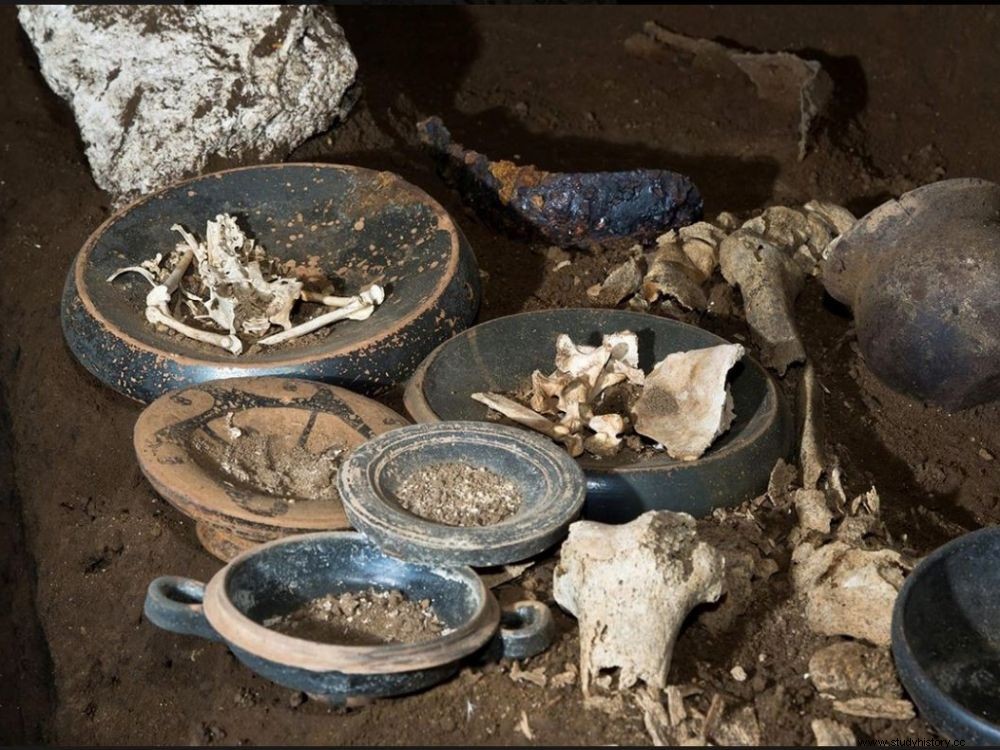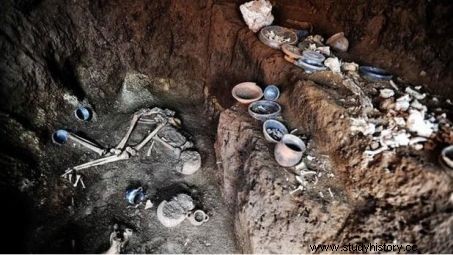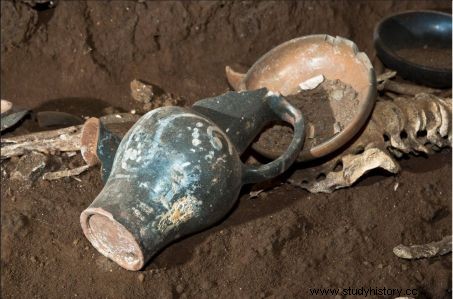An exceptional 2,300-year-old tomb has been unearthed in the Case Rosse area on the outskirts of Rome.

2300-year-old inviolate tomb recently discovered in the suburbs of Rome (Italy)
Italy and its rich archaeological past never ceases to amaze us. And not only in Pompeii, at the foot of the volcano Vesuvius, where extraordinary discoveries are underway (see Science and Future #856 currently on newsstands). Rome, the ancient ancient capital, is not left out to reveal its secrets. Including the best kept. Thus, in his suburbs, a worker had a providential pickaxe by accidentally revealing, during development work carried out as part of a preventive archeology intervention, the existence of an impressive tomb dug two meters depth. An inviolate vault found as it had been closed in the 4th century BC. Four skeletons - three men and a woman - lay there. Some on benches, others on the floor. Above all, accompanying these deceased on their final journey, a series of remarkable glazed ceramics, including plates, bowls and decorated amphoras, still contained food reliefs from a ritual banquet. Bones of rabbits, chickens and goats have been identified.
Italy and its rich archaeological past never ceases to amaze us. And not only in Pompeii, at the foot of the volcano Vesuvius, where extraordinary discoveries are underway (see Sciences et Avenir n°856 currently on newsstands ). Rome, the ancient ancient capital, is not left out to reveal its secrets. Including the best kept. Thus, in his suburbs, a worker had a providential pickaxe by accidentally revealing, during development work carried out as part of a preventive archeology intervention, the existence of an impressive tomb dug two meters depth. An inviolate vault found as it had been closed in the IV e century before our era. Four skeletons - three men and a woman - lay there. Some on benches, others on the floor. Above all, accompanying these deceased on their final journey, a series of remarkable glazed ceramics, including plates, bowls and decorated amphoras, still contained food reliefs from a ritual banquet. Bones of rabbits, chickens and goats have been identified.
Interior of the Roman Tomb of the Athlete. On the side benches, the remains of funerary offerings. © Soprintendenza Speciale Archeologia, Belle Arti and Paesaggio di Roma
"The offerings were intended to accompany the dead in the afterlife, in the grave as well as in the underworld “, explains the historian Yann Le Bohec, professor emeritus specialist in Roman antiquity at the University of Paris-IV.
Detail of glazed vase. ©Soprintendenza Speciale Archeologia, Belle Arti and Paesaggio di Roma
According to the estimate of experts from the Superintendency of Rome, the organization that is leading this work, the mortuary chamber dates back to the time of the Roman Republic, as a bronze coin dated between 335 and 312 BC seems to indicate. collected near a body. On one side emerges the face of Minerva, and on the reverse, a horse's head stamped with the word "Romano for Rome. Bronze strigils having been exhumed - sorts of slightly curved scrapers, toilet utensils that the ancient Greeks, Etruscans and Romans used to wipe themselves or remove sweat and oil in the thermal baths or after the gymnasium - the burial was baptized the "athlete's tomb".
But a question arises. Why buried figures? In Roman Antiquity, didn't people prefer to cremate bodies? “Archaeologists have long thought that the Romans systematically practiced incineration, but excavations carried out over several decades have overturned this certainty:throughout the Empire (including Gaul), some were cremated, and the others buried indistinctly “, specified the historian. This is confirmed by the historian of antiquity Philippe Fleury, director of CIREVE, at the University of Caen:"During the history of Rome, incineration and burial coexisted. Until the 2nd century AD, incineration seems to be clearly in the majority, while then it will be the opposite."
DNA testing will be performed on the skeletons to determine if there are any family ties.


